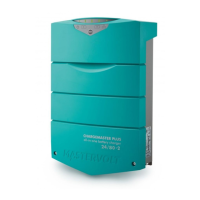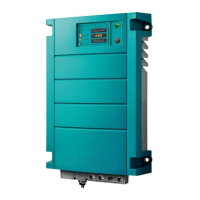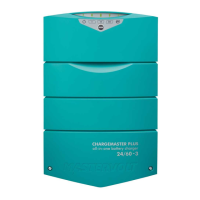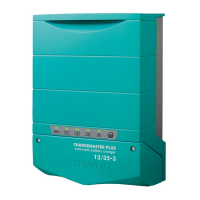INSTALLATION
8 February 2010 / Chargemaster 12/25-3, 24-12-3 / EN
4 INSTALLATION
During installation and commissioning of the
Chargemaster, the important safety instructions are
applicable at all times. See chapter 2 of this manual.
4.1 UNPACKING
After unpacking, check the contents for possible damage.
If in doubt, contact your supplier.
Check from the identification label (see section 1.4)
whether the battery voltage is the same as the nominal
output voltage of the Chargemaster (e.g. 24V battery set
for a 24V battery charger).
4.2 ENVIRONMENT
Obey the following stipulations during installation:
• The Chargemaster is designed for indoor use only.
• Operating ambient temperature: -25°C ... 60°C / -13°F
… 140°F (power derating above 25°C / 77 °F to
decrease the internal temperature).
• Humidity: 0-95% non condensing.
• Mount the Chargemaster preferably to a vertical wall,
with the connecting cables downwards.
• Make sure that the hot air developed during operation
can be discharged. The Chargemaster must be
mounted so that obstruction of the airflow through the
ventilation openings will be prevented.
• No objects must be located within a distance of 10 cm /
4 inches around the Chargemaster.
• Do not locate the Chargemaster in the same
compartment as the batteries.
• Do not install the Chargemaster straight above the
batteries because of possible corrosive sulphur fumes.
4.3 WIRING AND BATTERIES
WARNING!
The wire and fuse sizes stated in this manual
are given as example only. Prescribed wire
and fuse sizes may be different due to local
applicable regulations and standards.
4.3.1 DC wiring
Keep in mind that high current will pass through the DC
wiring. Keep the cable lengths shortest possible for
highest system efficiency. The recommended minimum
cross section of maximum 3m/ 9ft length battery cables for
output 1, 2 and 3 is:
Model Chargemaster DC cable cross section
12/25-3 6.0 mm² / 9 AWG
24/12-3 4.0 mm² / 11 AWG
Use ring terminals on the ends of the wires. The terminals
must be crimped with a proper crimping tool. Use the
following wire colours for DC wiring colour or at least
different colours to make a clear distinction between the
positive and negative wire from the battery:
Wire colour Meaning Connect to:
Red Positive + (POS)
Black Negative – (NEG)
Lay the positive and negative cables next to each other to
limit the electro magnetic field around the cables. The
negative cable should be connected directly to the
negative post of the battery bank or the ground side of a
current shunt. Do not use the chassis frame as the
negative conductor. Tighten securely. The positive battery
cable must be fused and connected to the positive post of
the battery bank.
The recommended cable fuses for outputs 1, 2 & 3 and
minimum battery capacities are:
Model Chargemaster Fuse Battery Capacity
12/25-3 32A 55Ah
24/12-3 16A 25Ah
4.3.2 AC safety grounding
WARNING!
The ground wire offers protection only if the
cabinet of the Chargemaster is connected to
the safety ground. Connect the ground
terminal (PE / GND) to the hull or the chassis.
CAUTION!
For safe installation it is necessary to Insert a
Residual Current Device (earth leakage
switch) in the AC input circuit of the
Chargemaster.

